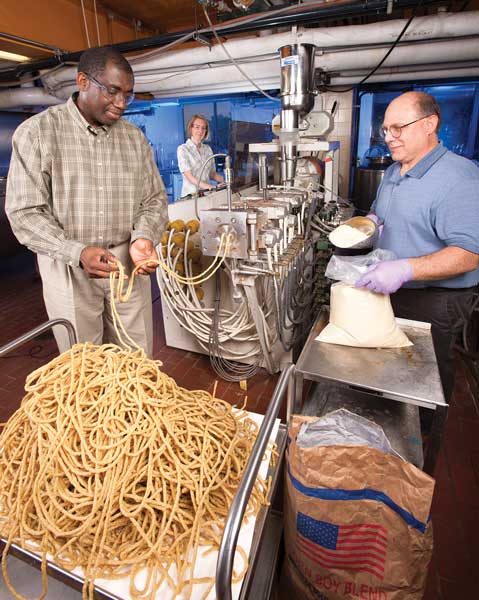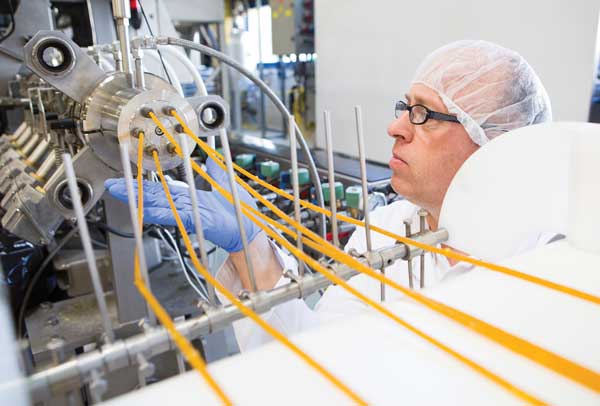How Extrusion Shapes Food Processing
PROCESSING
This month’s column will explore food extrusion. Extrusion is one of the most commonly used food manufacturing processes. Its versatility enables production of a diverse array of food products. This column will review the basic principles and provide an overview of applications. I would like to extend special thanks to my coauthor, Gilles Maller from Clextral, for contributing to the column.
Food extrusion was developed in the 1930s for dry pasta and breakfast cereal pellet production. In the 1950s, it was applied for pet food manufacturing. Over the past 80 years, applications of continuous extrusion processing have expanded as the technology has been developed as an alternative method for texturization, mixing, forming, reacting, and cooking of food.
According to IMARC Group, the global extruded snack food market had a value of $50 billion in 2016. It has grown at a rate of around 3% during the past seven years. Expectations for continued growth are forecast as emerging markets continue to develop due to increasing urbanization and continued busy lifestyles of consumers around the world. In addition, growing numbers of young consumers with increased disposable incomes will likely contribute to additional growth. Europe is currently the largest consumer of extruded snack foods.
 An Overview of Extrusion Technology
An Overview of Extrusion Technology
The food extruder is a short bioreactor that enables continuous transformation of raw ingredients into a wide range of final products. Extrusion has the advantage that it frequently is able to process foods in one manufacturing step. It is a widely used technology, producing hundreds of food products, including traditional snacks, breakfast cereals, pet food, ingredients, chewing gum, confections, pasta, texturized vegetable protein, premade cookie dough, baby food, processed cheese, bread, and more.
Simply described, the extruder is a continuous processing machine consisting of one or two screws (composed of a variety of screw elements) that are mounted on shafts and rotate in a fixed closed housing called a barrel. Single-screw extruders utilize one screw and twin-screw extruders use two intermeshing screws. Both styles of extruders operate in a similar manner, providing transport, compression, mixing, cooking, shearing, heating, cooling, and shaping of raw material final products.
As extrusion was introduced to various industries, it has replaced less efficient technologies such as batch processing and has also allowed the development of new products. The success of extrusion technology in the food industry is mainly due to its ability to continuously manipulate very viscous and complex fluids and powders. The basic processing functions are easily modified within the unit: heat and mass transfer; kneading and mixing; micro-mixing; and chemical reactions, cooking, and texturization.
The Extrusion Process
During extrusion, raw materials are forced to flow under controlled conditions along the length of the extruder barrel and through a shaped opening (called die assembly) at a defined throughput. First, raw materials are commonly ground to the preferred particle size. Frequently they are passed through a preconditioner in which other ingredients are added and steam may be injected. During extrusion the product is cooked and mixed by three separate energy sources: mechanical energy (shear caused by the screw elements), thermal energy that comes from the heating system, and self-heating due to the melt viscosity in the barrel. As the rheological behavior of the dough in the barrel greatly affects finished product quality, it is very important to control temperatures and process times to optimize food quality and heat transfer.
Variables that influence the extrusion process can be separated into three main categories: 1) Raw material composition and formulation (viscosity, moisture content, chemical composition); 2) thermomechanical cooking factors, including technology design (screw profile, length/diameter of the machine) and operating conditions (screw speed, temperature profile, water content, dry mix rate, residence time); and 3) die texturization factors (die design, insert shape, opening section).
There are four main categories of extrusion processes: cold, hot, steam-induced and co-extrusion. Cold extrusion is used to gently mix and shape dough without direct heating or cooking within the extruder. It is used mainly for producing pasta and dough. Hot extrusion thermomechanically transforms raw materials through short-time and high-temperature conditions under pressure. This type of extrusion is used mainly to cook raw materials to produce textured food and feed products. Steam-induced expansion defines the melt expansion at the die exit due to water flashing off, leading to highly expanded products. Subsequent processing then determines the textural attributes of extruded products. Examples of products produced using this type of extrusion are expanded snacks and breakfast cereals. Expanded co-extrusion combines steam-induced expansion and filling injection for expanded products with dual textures (usually crispy shell and soft filling).
Extruder manufacturers must offer highly flexible equipment to meet the broad scope of applications. For example, the material that the extrusion die is made from can have a significant effect on final product properties. Bronze dies are known to produce higher quality, rougher-surfaced pasta products than stainless steel dies. Flexible vertical cutting systems are popular with snack manufacturers to realize new product geometries, including cup-shaped snacks and a wide range of 3D shapes. As product development is usually performed on small-sized machines, it is critical to be able to scale up easily from an R&D machine to a production-sized extruder.
--- PAGE BREAK ---
Commercial Applications
This section provides a sampling of applications of extrusion to foods. In traditional applications, new grains and raw materials, including fruits and vegetables, are finding their way into snacks, cereal products, and even pet foods. The “good for you” trend is growing and processors are including ancient grains, including quinoa, amaranth, and spelt that add protein; phytonutrients; calcium; iron; and interesting flavors to extruded foods. Sweet potato and other root vegetables offer a valued fiber component.
Recently extrusion technology has enabled development of third-generation food products, known as “half products.” These are multidimensional products that are extruded and later puffed, popped, or fried, providing new textures and eating experiences to consumers.
Co-extruded snacks and bars with crispy outer shells and creamy fillings have gained momentum as extrusion processing advances have improved product textures (defined by their cell structure) and new ingredients, including visible inclusions, have enhanced the consumer appeal of these products.
Texturized plant-based “meats”—fibrated proteins that mimic the appearance, flavor, texture, and mouthfeel of meat, poultry, and/or seafood are another application that is rapidly gaining in popularity. These foods have the same moisture as meat and are formed into chunks, slices, shreds, or custom shapes. For these products, legume proteins are texturized.
Extruded encapsulated flavors are used as food ingredients for many foods. The extrusion process provides excellent dispersion of the sensitive flavors in the matrix and provides extended shelf life for the aromatic molecules.
Precooked flours are fast-dissolving or instant cereal–based preparations that, when rehydrated (with water or milk), provide a soup, mush, cream, or dough. These extruded flours are widely used in cereal-based baby foods. They are nutritionally balanced and easy to store, transport, and prepare.
 Many functional ingredients, including modified starches, yeasts, dairy products, and caseinates are processed by extrusion (via heat treatment, enzymatic or chemical hydrolysis, emulsification, pressing etc.). With extrusion, it is possible to mix carriers with the active ingredients for enhanced functionality. Clextral has developed an extrusion porosification technology (EPT) that transforms high-value food concentrates into flowable, easily rehydrated powders that retain the essential properties of the original ingredients.
Many functional ingredients, including modified starches, yeasts, dairy products, and caseinates are processed by extrusion (via heat treatment, enzymatic or chemical hydrolysis, emulsification, pressing etc.). With extrusion, it is possible to mix carriers with the active ingredients for enhanced functionality. Clextral has developed an extrusion porosification technology (EPT) that transforms high-value food concentrates into flowable, easily rehydrated powders that retain the essential properties of the original ingredients.
Pet food and animal and aquatic feeds have been processed by extrusion for many years. Today, processors are incorporating new ingredients and functionality into these products to enhance nutrition, reduce processing costs, and, for pet foods, to include consumer-preferred attributes like high protein and vegetable content.
Equipment Suppliers
There are many global suppliers of food manufacturing equipment. Some manufacturers of single-screw extruders include American Extrusion International, South Beloit, Ill.; Extru-Tech, Sabetha, Kan.; Schaaf Technologie, Bad Camberg, Germany; and Wenger, Sabetha, Kan. Some twin-screw extruder manufacturers include Buhler, Uzwil, Switzerland; Baker Perkins, Grand Rapids, Mich.; Clextral, Firminy, France; Coperion, Stuttgart, Germany; Leistritz, Nuremberg, Germany; and Wenger. C.W. Brabender, South Hackensack, N.J., is one of many pilot-scale extruder manufacturers.
Vision for the Future of Extrusion Technology
When compared with many traditional processes, extrusion is more efficient, economical, and requires fewer resources (energy, water) at less cost. The technology is also highly versatile, allowing multiple products to be processed on one extruder or processing line. These factors support a bright future for extrusion.
In addition, it is anticipated that global trends around consumers’ desire for foods that are healthy, convenient, of premium quality, and ethically produced will drive demand for healthy, high-fiber extruded foods and functional ingredients in future years. Continued growth in demand for plant protein–based foods in affluent countries will also drive growth. As seafood demands increase, extrusion offers new resources that will support sustainability in that industry. Extrusion is also expected to contribute to solving the problem of world hunger. Finally, development of new ancillary equipment that can be attached to extruders to enhance textures and eating characteristics will also fuel growth of this transformative technology.
 Tara McHugh, PhD, Contributing Editor
Tara McHugh, PhD, Contributing Editor
Research Leader, USDA Agricultural Research Service, Albany, Calif.
[email protected]
Gilles Maller is vice-president, international & technologies, Clextral ([email protected]).


